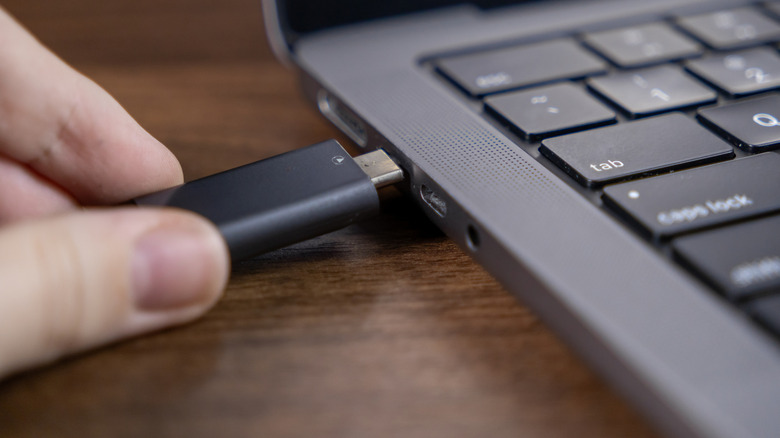You're Probably Plugging These Everyday Devices Into The Wrong USB Port
Whether you're connecting a printer to your desktop computer or adding a mouse to your laptop, you might just be using the USB port closest to you. But it actually does matter which port you're plugging into. For example, external hard drives and flash drives typically operate best with the newer USB 3.2 (up to 10 Gbps), or USB4, one of the fastest USB ports (between 20 and 40 Gbps), to ensure you get the quickest data transfer possible. Webcams streaming HD and 4K video, as well as VR headsets, also need faster ports to deliver great performance. The slower USB 2.0 (up to 480 Mbps), may not be enough.
However, USB 2.0 is still great for some devices. Printers, scanners, keyboards, and mice fall into this category, as they're not moving that much data. The same is true for audio interfaces and microphones, which just don't need that much bandwidth to send an audio file. Plus, if your mic's not plugged into the right port, your audio may not be as clear as you'd like.
When it comes to finding the right ports for your devices, check the symbols and icons next to each port. A standard USB 2.0 port usually just has a USB icon. USB 3 speeds should have an "SS" or "SuperSpeed." A USB4 port will typically have a circular logo next to it. Also, keep in mind that rear ports offer more stable power than front ports, as they're connected directly to your computer's motherboard.
Colors, cables, and compatibility
If you're using a newer model laptop or desktop computer, you may be able to identify the different USB ports by color. Black ports are typically for USB 2.0, which isn't very fast, but can be suitable for a number of devices. Blue USB ports are for speeds of 3.0, and teal ports are designed for USB 3.1 Generation 1 or higher. If your computer has red or yellow USB ports, you can use them to charge your phone or tablet. Basically, if a device needs charging, you can plug it in, as these ports are always working and ready to go.
Unfortunately, the USB cables themselves may not be clearly labeled. Since cables are built to perform to the level of their corresponding ports, it's important to make sure you have the right ones. Of course, the easiest method is to use the cord that came with your device. But if you had to replace it for some reason, check the box the new cord was packaged in. If there's no direct information about the USB type, check for the cable's overall speed or wattage rating.
When in doubt about USB compatibility, consult your owner's manual. You should get all the info you need about USB type, speeds, and more. Or you can visit the manufacturer's websites for your devices and your computer. It's always best to be informed and know exactly which ports will give you the performance you're looking for.

